Understanding the intricacies of flea dirt is paramount for pet owners seeking to maintain a healthy environment for their furry companions.
From identifying the telltale signs of infestation to implementing effective eradication methods, the battle against flea dirt requires knowledge and diligence.
By unraveling the mysteries behind flea dirt and discovering practical solutions to combat it, individuals can safeguard their pets and homes from the perils of fleas.
Let's embark on a journey to uncover the secrets of flea dirt and equip ourselves with the tools needed to combat this pervasive nuisance.
Key Takeaways
- Flea dirt is a sign of a flea infestation and ineffective treatment.
- Removing flea dirt requires pet-friendly shampoo, bathing, and grooming.
- Treat your home by washing bedding, vacuuming, and controlling humidity.
- Prevent flea dirt by maintaining year-round flea prevention for pets and homes.
Understanding Flea Dirt
Flea dirt, the excrement of adult fleas, serves as a telltale sign of a flea infestation and is commonly dark red-to-black in color, containing undigested blood.
This fecal matter is often found on pet bellies, near their hindquarters, or within their bedding.
Despite adult fleas comprising only 5% of the total flea population, the presence of flea dirt indicates a more extensive infestation involving eggs, larvae, and pupae.
Identifying and understanding flea dirt is crucial in recognizing the need for effective flea control measures. Regular grooming and thorough examination of pets can aid in early detection, allowing for prompt treatment to prevent further infestation and potential health risks associated with fleas.
Risks of Flea Dirt
Recognizing the potential dangers associated with the presence of flea dirt is crucial for pet owners to take proactive measures in addressing and preventing flea infestations. Flea dirt serves as an indicator of ineffective current flea treatment, suggesting the need for more robust prevention methods.
Moreover, the presence of flea dirt signifies the potential transmission of diseases by fleas, including Bartonellosis, tapeworms, typhus, and even plague. While flea dirt itself does not directly cause pet allergies, the fleas collected from pets can harbor illness-causing organisms, posing a risk to both animals and humans.
Therefore, prompt action to remove flea dirt and implement comprehensive flea control measures is essential to safeguard the health and well-being of pets and households.
Removing Flea Dirt From Pets
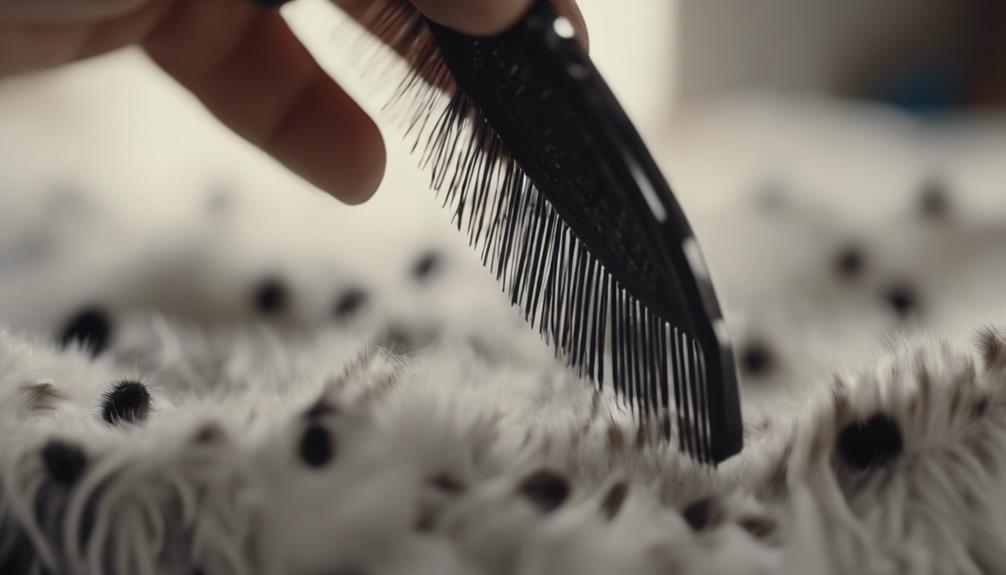
When addressing the issue of removing flea dirt from pets, proper hygiene practices play a crucial role in effectively managing flea infestations and ensuring the well-being of animals.
To effectively remove flea dirt from pets, consider the following steps:
- Use a non-irritating shampoo for pets: Choose a gentle shampoo specifically formulated for pets to avoid skin irritation.
- Wash off flea dirt with a thorough bath: Ensure to cover all areas where flea dirt is present, paying attention to the belly and behind.
- Consider multiple rounds of shampooing for severe cases: In cases of heavy flea dirt infestation, multiple baths may be necessary.
- Use a flea comb to remove dirt and live fleas: Comb through the pet's fur to physically remove flea dirt and live fleas, aiding in the cleaning process.
Non-Irritating Shampoo for Pets
Proper pet hygiene, particularly in addressing flea infestations, involves selecting a non-irritating shampoo formulated specifically for pets. When choosing a shampoo to combat flea dirt, opt for products that are gentle on your pet's skin to prevent any potential irritation.
Look for shampoos that are labeled as safe for frequent use and contain ingredients like oatmeal or aloe vera known for their soothing properties. Avoid shampoos with harsh chemicals or fragrances that may exacerbate skin sensitivities.
Regular baths using a non-irritating shampoo can help effectively remove flea dirt and keep your pet clean and comfortable. Prioritize your pet's well-being by investing in a high-quality, gentle shampoo tailored to their specific needs.
Thorough Bath for Pets
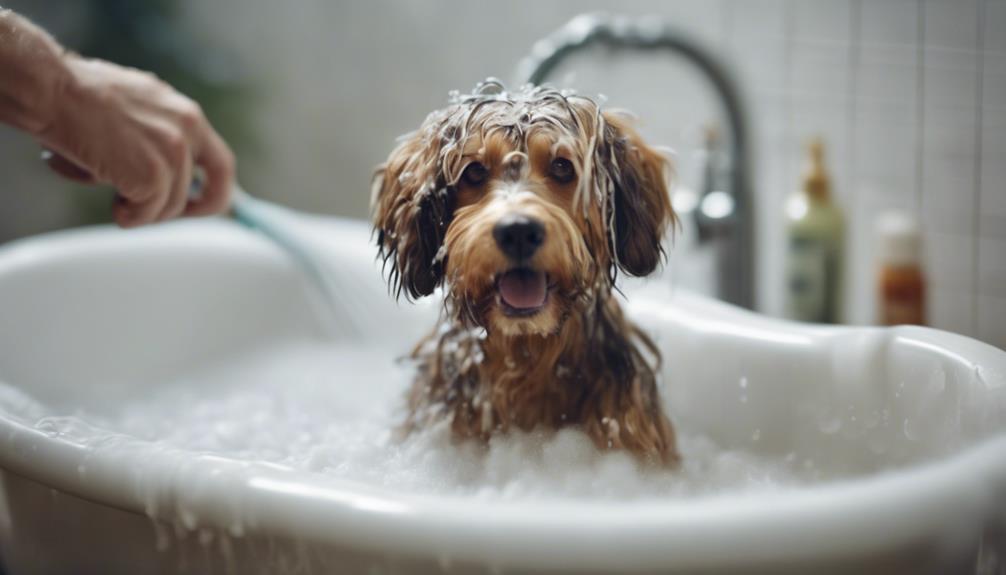
For optimal flea dirt removal and pet hygiene, a thorough bath is essential in maintaining your pet's cleanliness and well-being. To ensure a successful flea dirt removal process, follow these steps:
- Use a gentle pet shampoo to avoid skin irritation.
- Thoroughly wash your pet to remove all flea dirt and debris.
- Utilize a flea comb to help eliminate any remaining dirt and live fleas.
- Regular grooming sessions can aid in the early detection of flea infestations and promote overall pet health.
Multiple Shampoo Rounds for Severe Cases
To address severe cases of flea infestations, particularly when standard treatment methods prove insufficient, multiple rounds of shampooing may be necessary to effectively eliminate flea dirt and live fleas from pets.
In such situations, it is crucial to use a gentle yet effective pet shampoo specifically designed for flea removal. The process involves thoroughly lathering the pet's coat, focusing on areas where flea dirt is most prevalent. Rinse the shampoo completely and repeat the process if needed to ensure all fleas and flea dirt are removed.
While multiple rounds of shampooing can be more time-consuming, they are often necessary for severe cases to fully eradicate the infestation and prevent re-infestation.
Flea Comb for Dirt and Live Fleas
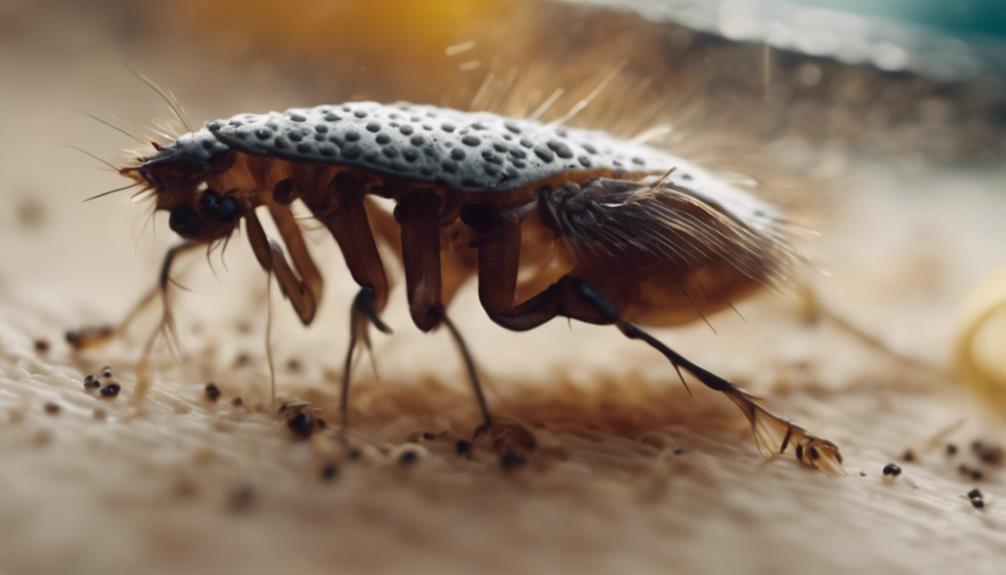
When addressing the presence of flea dirt and live fleas on pets, utilizing a flea comb proves to be a valuable tool for effective removal and prevention of further infestation. The flea comb helps in physically removing both the dirt and live fleas from the pet's fur, aiding in the control of flea populations.
Here are some key points to consider when using a flea comb:
- Start combing from the pet's head and move towards the tail, focusing on areas where fleas are commonly found.
- Dip the comb in soapy water after each stroke to drown and kill the fleas.
- Comb your pet regularly, especially during peak flea seasons, to catch and eliminate fleas early.
- Dispose of any collected fleas in a sealed bag to prevent re-infestation.
Regular Grooming for Early Detection
Regular grooming of pets plays a vital role in the early detection of flea infestations and other potential health issues. By regularly grooming your pets, you can spot signs of fleas, such as flea dirt, before a full-blown infestation occurs. Additionally, grooming allows for the early detection of skin irritations, lumps, or other abnormalities that may require veterinary attention. To emphasize the importance of grooming in maintaining your pet's health, consider the following table:
| Benefits of Regular Grooming |
|---|
| Early detection of fleas |
| Monitoring skin conditions |
| Checking for lumps |
| Preventing matting |
| Maintaining coat health |
Treating Your Home for Flea Dirt
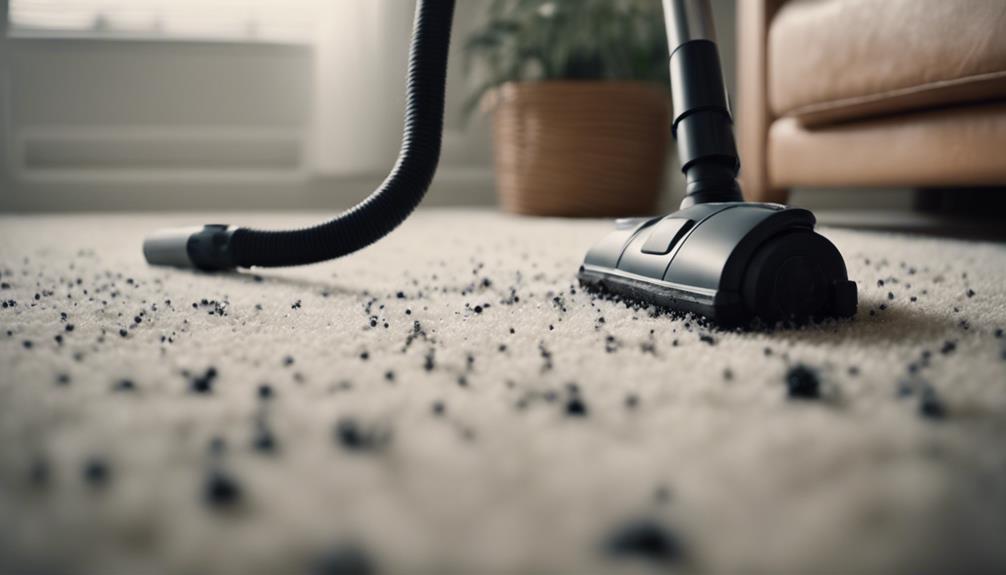
Effective removal of flea dirt from your home environment is essential in eradicating flea infestations and preventing reinfestation. To effectively treat your home for flea dirt, follow these steps:
- Wash all bedding: Remove flea feces, eggs, and larvae by washing all bedding thoroughly.
- Vacuum carpets: Eliminate fleas and remnants by vacuuming carpets multiple times.
- Check indoor environments: Indoor areas can harbor immature flea stages, so pay close attention to these areas.
- Inspect outdoor areas: Check shaded outdoor spots with sand, as immature flea stages thrive in specific humidity and temperature conditions.
Washing Bedding to Remove Flea Residues
To thoroughly eliminate flea residues from your home environment, a crucial step involves washing all bedding to eradicate flea feces, eggs, and larvae effectively. Washing bedding in hot water and drying it on high heat can help kill fleas at all life stages, breaking the flea life cycle. Here is a table to guide you on washing bedding to remove flea residues:
| Steps to Wash Bedding | Tips for Effective Cleaning |
|---|---|
| Use hot water | Kills fleas and larvae |
| Use detergent | Helps remove flea dirt |
| Dry on high heat | Kills remaining fleas |
| Repeat if necessary | Ensures thorough cleaning |
Vacuuming Carpets for Elimination
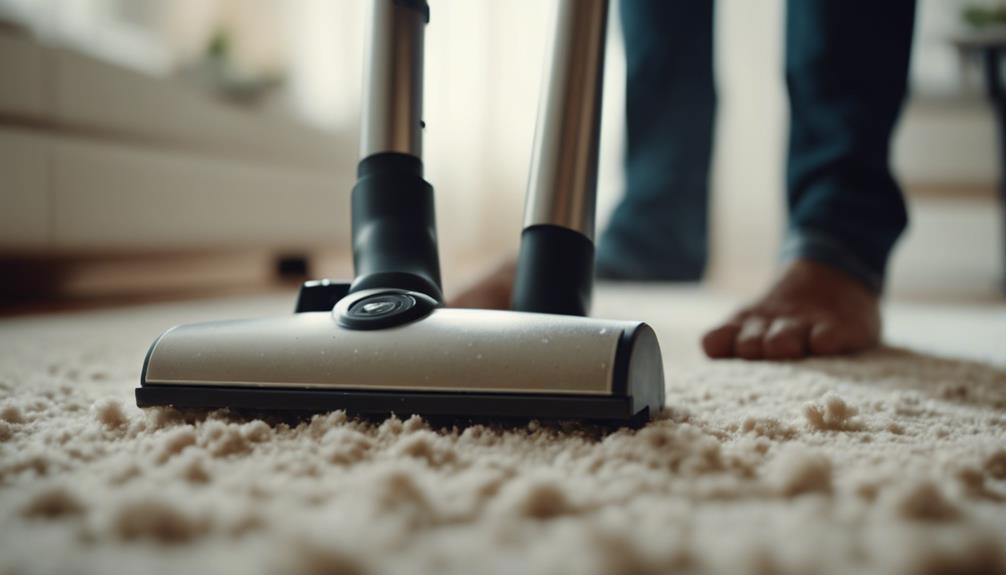
Vacuuming carpets is a fundamental step in eliminating flea residues and remnants from indoor environments.
- Use a high-powered vacuum cleaner with a HEPA filter to effectively remove flea eggs, larvae, and pupae.
- Focus on areas where pets frequent and rest, such as pet bedding, carpets, rugs, and upholstery.
- Empty the vacuum cleaner bag or canister immediately after each use to prevent fleas from re-infesting your home.
- Vacuum high-traffic areas daily and less frequented areas at least once a week to disrupt the flea life cycle and reduce infestation levels.
Checking Outdoor Areas for Flea Development
Inspecting Outdoor Areas for Flea Development is essential in comprehensive flea control measures for your pet's well-being and your home's cleanliness. Outdoor areas, especially those with shaded spots and sandy areas, can be hotspots for flea development. Fleas prefer humid and warm conditions, making these environments ideal for their growth and reproduction.
To check for flea development, inspect areas where your pet spends time outdoors, such as under decks, bushes, and in sandy patches. Look for signs of flea activity like flea dirt, eggs, or larvae. By identifying and addressing outdoor flea development early on, you can prevent infestations from spreading indoors and protect your pet from the discomfort and health risks associated with fleas.
Understanding Flea Development Factors
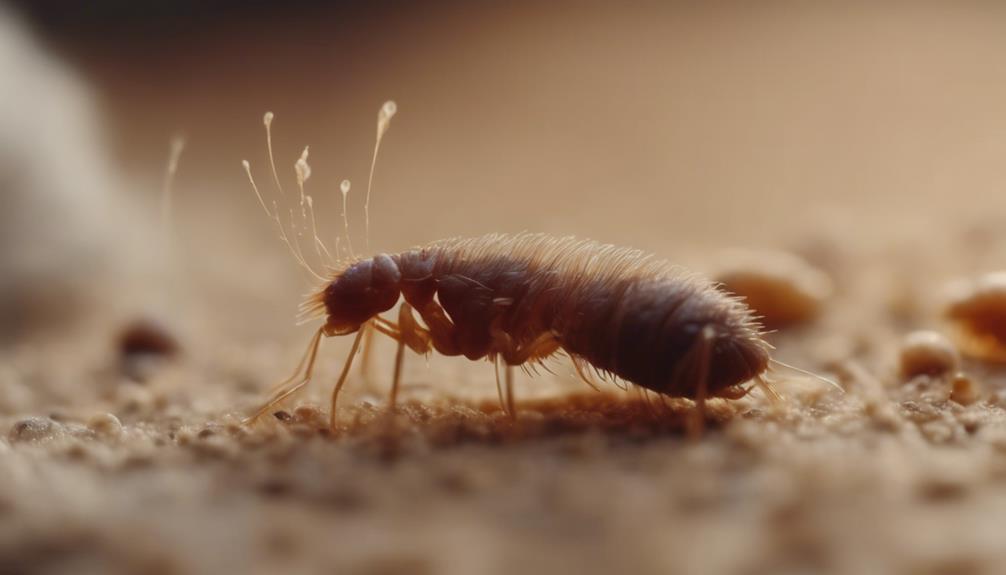
Understanding the crucial factors influencing flea development is paramount in effectively managing and preventing flea infestations in both pets and homes.
- Temperature: Fleas thrive in temperatures between 70-85°F.
- Humidity: Flea larvae require humidity levels of 70% or higher to develop.
- Host Availability: Fleas depend on hosts like pets for blood meals and reproduction.
- Environmental Conditions: Factors like carpeting, bedding, and outdoor spaces can influence flea development.
Preventing Fleas and Flea Dirt
To effectively safeguard your pets and home from flea infestations and the presence of flea dirt, maintaining a consistent year-round flea prevention protocol is essential. Cat fleas are the primary concern for pets in North America, making prevention strategies crucial.
It is important to regulate home humidity and temperature to deter flea development. Seeking veterinary guidance for eradication and prevention methods can help ensure effective protection.
Consistent flea treatment throughout the year is paramount in preventing infestations and the resulting flea dirt. By implementing these preventative measures, you can significantly reduce the risk of flea infestations, keeping your pets and home free from the troubles associated with fleas and their feces.
Conclusion
In conclusion, understanding flea dirt is essential for pet owners to effectively manage and prevent flea infestations. By recognizing the risks associated with flea dirt and taking proactive steps to remove it from pets and living spaces, individuals can protect their beloved animals from the harmful effects of fleas.
Implementing regular grooming, cleaning, and preventative measures can help maintain a healthy environment for both pets and humans. Stay vigilant and proactive in combating flea dirt to ensure the well-being of your furry companions.




